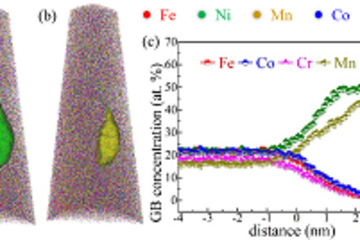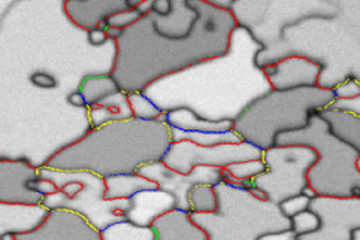All genres
401.
Journal Article
In-process Precipitation During Laser Additive Manufacturing Investigated by Atom Probe Tomography. Microscopy and Microanalysis 23 (S1), pp. 694 - 695 (2017)
402.
Journal Article
Atomic scale characterization of white etching area and its adjacent matrix in a martensitic 100Cr6 bearing steel. Materials Characterization 123, pp. 349 - 353 (2017)
403.
Journal Article
Strong and Ductile Non-equiatomic High-Entropy Alloys: Design, Processing, Microstructure, and Mechanical Properties. JOM-Journal of the Minerals Metals & Materials Society 69 (11), pp. 2099 - 2106 (2017)
404.
Journal Article
Interstitial atoms enable joint twinning and transformation induced plasticity in strong and ductile high-entropy alloys. Scientific Reports 7, 40704 (2017)
405.
Journal Article
Reply to the ‘Comments on “Dental lessons from past to present: ultrastructure and composition of teeth from plesiosaurs, dinosaurs, extinct and recent sharks”’ by H. Botella et al., RSC Adv., 2016, 6, 74384–74388. RSC Advances 7 (11), pp. 6215 - 6222 (2017)
406.
Journal Article
Simulation of thermo-mechanical stresses in Ag/SnO2 materials after arcing events [Simulation thermomechanischer Spannungen in Ag/SnO2-Werkstoffen nach Lichtbogenbelastung]. VDE Fachberichte 73, pp. 114 - 122 (2017)
407.
Journal Article
Entwicklung schadenstoleranter Dualphasenstähle. Stahl und Eisen 137, p. 88 - 88 (2017)
408.
Journal Article
Complexion-mediated martensitic phase transformation in Titanium. Nature Communications 8, 14210, pp. 1 - 8 (2017)
409.
Journal Article
Combinatorial screening of the microstructure–property relationships for Fe–B–X stiff, light, strong and ductile steels. Materials and Design 112, pp. 131 - 139 (2016)
410.
Journal Article
Effects of Mn additions on microstructure and properties of Fe–TiB2 based high modulus steels. Materials and Design 111, pp. 185 - 191 (2016)
411.
Journal Article
Efficient additive manufacturing production of oxide- and nitride-dispersion-strengthened materials through atmospheric reactions in liquid metal deposition. Materials and Design 111, pp. 60 - 69 (2016)
412.
Journal Article
Multiple mechanisms of lath martensite plasticity. Acta Materialia 121, pp. 202 - 214 (2016)
413.
Journal Article
A phase field model for damage in elasto-viscoplastic materials. Computer Methods in Applied Mechanics and Engineering 312, pp. 167 - 185 (2016)
414.
Journal Article
Atom probe tomography of intermetallic phases and interfaces formed in dissimilar joining between Al alloys and steel. Materials Characterization 120, pp. 268 - 272 (2016)
415.
Journal Article
A crystal plasticity model for twinning- and transformation-induced plasticity. Acta Materialia 118, pp. 140 - 151 (2016)
416.
Journal Article
Improving the mechanical properties of Fe – TiB2 high modulus steels through controlled solidification processes. Acta Materialia 118, pp. 187 - 195 (2016)
417.
Journal Article
Autonomous Filling of Grain-Boundary Cavities during Creep Loading in Fe–Mo Alloys. Metallurgical and Materials Transactions a-Physical Metallurgy and Materials Science 47 (10), pp. 4831 - 4844 (2016)
418.
Journal Article
Deformation-Induced Martensite: A New Paradigm for Exceptional Steels. Advanced Materials 28 (35), pp. 7753 - 7757 (2016)
419.
Journal Article
Ultra-strong and damage tolerant metallic bulk materials: A lesson from nanostructured pearlitic steel wires. Scientific Reports 6, 33228 (2016)
420.
Journal Article
Functional adaptation of crustacean exoskeletal elements through structural and compositional diversity: a combined experimental and theoretical study. Bioinspiration & Biomimetics 11 (5), 055006 (2016)











